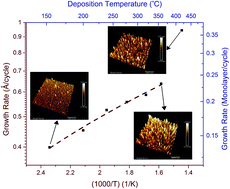Structure–property relationship and interfacial phenomena in GaN grown on C-plane sapphire via plasma-enhanced atomic layer deposition
Abstract
Gallium nitride films were deposited via plasma-enhanced atomic layer deposition (PEALD) using triethylgallium and forming gas as precursors. An optimized process was developed and the effect of growth temperature on the structure and optical properties of the films investigated. In-depth X-ray diffraction analyses show that there is a critical temperature, below which the films are amorphous. Raising the growth temperature above the critical temperature increases the grain size of the polycrystalline film, while degrading the degree of preferred orientation. Azimuthal XRD scans show clear signs of a crystallographic relationship between the (002) planes of the sapphire substrate and GaN. Growth rate shows a steady rise until a rapid jump at 425 °C occurs. The study of the surface profile by AFM shows that the hillocks on the surface start to grow in diameter as well as height, increasing the total growth front area. This also decreases the surface roughness. XRR studies reveal that mass density reaches its maximum value at 240 °C, and is stable after that. Carrier mobility is increased by two orders of magnitude, when the growth temperature is raised from 150 °C to 425 °C. As expected, a similar but reverse trend was observed for the electrical resistivity. Refractive index follows the trends of mass density and crystal quality with a clear increase at the onset of crystallinity. Overall, the surface profile and the engineering properties improve as growth temperature is increased. At the high end of the growth temperature range, PEALD GaN films grown on (002) sapphire were p-type with a hole mobility of 575 cm2 V−1 s−1.


 Please wait while we load your content...
Please wait while we load your content...